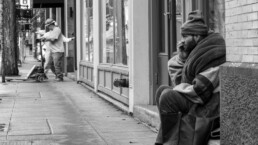Economic data doesn’t suggest that the US economy is in a recession, but Americans’ on-the-ground experiences tell a different story. Extreme income inequality can explain the discrepancy between the economic data and the real-world belt tightening.
by Julian Jacobs, Jacobin
In 2022, Marla, a thirty-two-year-old retail store manager in Chicago, began to feel the first signs of an economy under strain. As COVID stimulus benefits dried up and prices surged, her wages became harder to live on. Her credit card debt increased, and she fell further behind on student loan payments, all while higher interest rates made borrowing more difficult. When asked about her outlook, Marla discussed her fears for the future. Would she ever be able to own her own home? And could she afford to have kids while her economic life remained so uncertain?
Experiences like Marla’s, which were shared by millions of Americans last year, often accompany an economic downturn. But a glance at economists’ preferred benchmarks for a recession seemed to reveal an economy that was still robust. This includes strong consumption figures and the appearance of tight labor markets. And although there has certainly been an increase in financial market volatility as well as a wave of equity sell-offs and job cuts in the tech sector, key indexes do not obviously indicate an economy on the brink of a recession.

What is going on with the American economy? Why do the traditional indicators that capture the country’s economic health stand in such stark contrast to the lived experiences of so many people, including the 32 percent of American adults who are falling behind on debt payments and the 25 percent of US parents who have struggled to afford food or housing in the last year.
A closer look at the US economy reveals a country with bifurcated economic experiences. Indeed, it is ultimately America’s historically high levels of wealth and income concentration that can best explain the dissonance between aggregated economic figures and middle- and lower-income Americans’ daily realities.
Recent Posts
Mayor Mamdani’s First Day, A Zero Hour Conversation With Richard Wolff
July 2, 2025
Take Action Now If elected, what would Mayor Mamdani do on his first day in City Hall? How would a democratic socialist govern as a big-city mayor?……
The U.S. Is Funding A Bloodbath At Gaza Aid Centers
July 2, 2025
Take Action Now The admin just gave $30M to GHF, the organization at the center of charges that Israel is weaponizing assistance and shooting at…
Feeding The Warfare State
July 1, 2025
Take Action Now We Lose, the Weapons Makers WinBy William D. Hartung, Tom Dispatch The Senate is on the verge of passing the distinctly misnamed…
The Rage Of Billionaires And The Frenzy To Stop Zohran Mamdani From Becoming New York’s Mayor
June 30, 2025
Take Action Now The constellation of forces now regrouping with a vengeance includes titans of Wall Street, enormous real estate interests,…




